Podcast: Play in new window | Download (Duration: 19:56 — 20.9MB)
Sign up for our mailing list! We also have t-shirts and mugs with our logo!
This week we visit the weirdest squid in the deep sea!
I was a guest on Tim Mendees’s After Hours that’s now up on YouTube! It’s mostly about my writing but we talk about all kinds of stuff, including cephalopods! There is some bad language but it’s not all that bad and it’s mostly toward the end.
Further reading/watching:
Elusive Long-Tailed Squid Captured on Film for First time
See Strange Squid Filmed in the Wild for the First Time (ram’s horn squid)
Untangling the Long-Armed Mystery of the Bigfin Squid
Drawing of a long-arm squid and an actual long-arm squid:
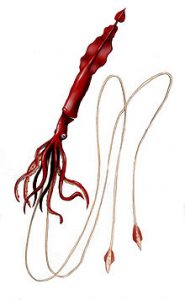
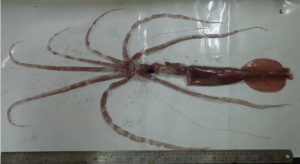
Asperoteuthis mangoldae, which really should be called the long-tailed squid:
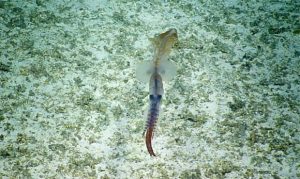
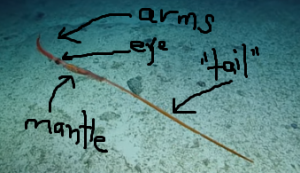
Verany’s long-armed squid, with its tentacles mostly retracted (so not looking very long-armed):
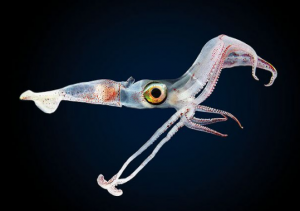
Verany’s long-armed squid with tentacles extended:
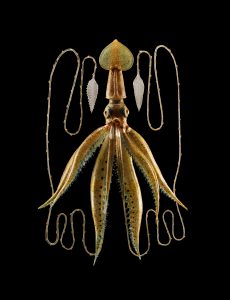
Drawing of a paralarval Verany’s long-armed squid:

The ram’s horn squid, floating along doop doop doop:
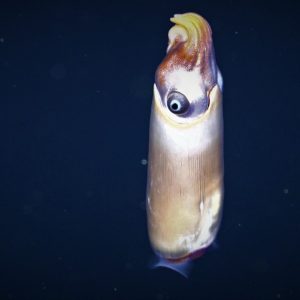
Drawing of the coiled internal shell of the ram’s horn squid:
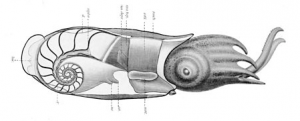
A clawed armhook squid mama with her egg cluster:
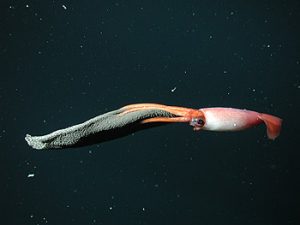
Bigfin squid!
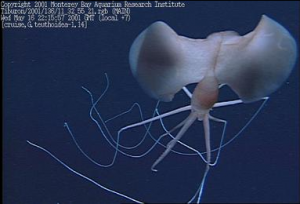
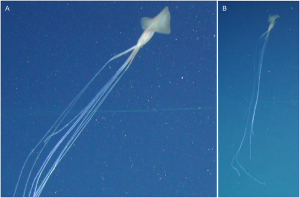
Another bigfin squid! Good grief look at that!
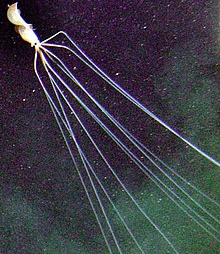
Show transcript:
Welcome to Strange Animals Podcast. I’m your host, Kate Shaw.
Before we get started, a quick announcement that I was a guest on a YouTube show called After Hours recently! I was there mostly to talk about my writing, but naturally animals came up too, especially cephalopods. There’s a link in the show notes if you want to watch the show. There is a little bad language, but not too bad and it’s more toward the end.
Anyway, in a not-exactly coincidence, this week we’re going to look at some of the weirdest deep-sea squids known. Yes, weirder than the flying squid we talked about in episode 101. We don’t know much about any of them, but they’re definitely not what you expect when you think about squid.
Let’s talk first about Asperoteuthis acanthoderma, the long-arm squid. It’s also sometimes called the thorny whiplash squid because it has little pointy tubercules in its skin and long, whiplike feeding tentacles. It lives in the deep sea and has been found in both the Pacific and the Atlantic Oceans, although very rarely. Despite its name, its feeding tentacles are much longer than its arms, although its arms are pretty long too. A squid’s body is generally more or less torpedo-shaped and is called a mantle. It has eight arms and two feeding tentacles that are usually longer than the arms. Many squid species have relatively short arms compared to mantle length.
The feeding tentacles in long-arm squid are very slender and delicate, and they’re easily broken off after the animal dies and has washed around in the water for a while. One intact specimen has been found and measured, though. It had a mantle length of almost a foot and a half long, or 45 cm, but its total length, including the tentacles, was 18 feet, or 5.5 meters. The tentacles were 12 times the mantle length.
Using that ratio, one large specimen found in 2007, which was 6 1/2 feet long, or 2 meters, including both mantle and arms, is estimated to have measured up to 24 feet long when it was alive, or over 7 meters. Most of its length is due to its incredibly long, thin feeding tentacles.
So what does the long-arm squid eat with those long, delicate tentacles? We don’t know. We don’t know most things about the long-arm squid.
Another species of Asperoteuthis is Asperoteuthis mangoldae. So little is known about it that it doesn’t even have an informal name. It was only described in 2007 and has only been found around the Hawaiian islands in the Pacific Ocean. It looks similar to the closely-related long-arm squid but without the incredibly long feeding tentacles. Instead, it has a sort of tail, so I nominate it to be called the long-tailed squid. It was caught on video for the first time in 2019 by a deep-sea rover. You’re going to hear a lot about deep-sea rovers in this episode. There are lots of links in the show notes to articles with embedded video of various squids, which is really interesting to watch.
Asperoteuthis mangoldae is a long, slender squid. I couldn’t find any measurements so it could be that’s just not known right now. The species in this genus have an extension of the mantle, on the side opposite of the arms, that looks like an extra fin but that doesn’t seem to be used as a fin. In the long-tailed squid, this extra fin is as long as its mantle and arms and feeding tentacles all measured together. Most of the time the thin flaps of skin on either side of the so-called tail are extended, making it look like a really long fin, but when the squid feels threatened and needs to flee, it collapses the fin part around the middle section so that it reduces drag in the water. That way the squid can move faster. Researchers speculate that the tail section may make the squid look much larger to potential predators, and possibly may imitate an organism called a siphonophore that has stinging cells.
Another squid called Verany’s long-armed squid is Chiroteuthis veranii. It’s related to the long-arm squid we talked about at the beginning of the episode, but they’re placed in different genera. It lives throughout the world’s oceans, often in the deep sea although not as deep as some of the species we’re talking about today. Unlike most squid, whose arms are all about the same length, two of its arms are much wider and longer than the others.
Like the other long-arm squid, its feeding tentacles are incredibly long and thin. The mantle is quite small, up to 8 inches long, or 20 cm, with the legs about the same length as or a little longer than the mantle, but the total length of this squid, including the feeding tentacles, is over four feet, or 130 centimeters. Most of the time the feeding tentacles are retracted, though, so they’re no longer than the arms, and they’re protected by the two largest arms. When the squid sees a tiny fish or crab or other small animal it wants to eat, it can shoot its retracted tentacles out at high speed to catch it. It’s probable that other species of long-armed squid hunt the same way.
A squid’s eggs hatch into an initial form called a paralarva. This is actually the case for other cephalopods too, including octopuses. The paralarvae usually just look like teeny-tiny miniature versions of the adult, but with stubby little arms. In the case of Verany’s long-armed squid, though, the larval squid looks sort of like a little rod. It’s long and thin, mostly transparent, and has a gladius, also called a pen, that sticks out the end of the mantle on the opposite side from the arms. The pen of a squid is named after an ink pen, although the other name, gladius, refers to the shape of a type of ancient Roman sword. It’s a vestigial shell but located inside the squid’s body. The tail of the long-tailed squid we just talked about is given structure by the gladius, so it’s possible that its paralarvae look rod-like, like those of Verany’s long-armed squid.
Speaking of internal shells, the ram’s horn squid has a coiled internal shell. This is unique among all the squid known to be alive today, so the ram’s horn squid is the only living member of its own order and its own family and its own genus. Technically it’s not really considered a squid although it is a closely related cephalopod. It’s small, with a mantle length only about an inch and a half long, or 4.5 centimeters. Its eight arms are quite short and it has two feeding tentacles that are about the same length as its mantle. Its mantle has an outer covering that extends down almost to the squid’s eyes, and it’s big enough that the squid can pull its eyes and legs and tentacles under this covering. The spiral shell resembles that of a nautilus, but it’s inside the squid instead of the nautilus living inside the shell. The shell contains gas that the squid uses to adjust its buoyancy.
For a long time researchers were confused as to how the ram’s horn squid oriented itself in the water. The empty shells from dead squid wash ashore pretty often, and experiments with them show that they want to float with the big end of the shell pointing downward. That confused the researchers, since that would mean the squid floats around with its arms downward too, which means that the photophore on the tail end of its mantle points upward. A photophore is a light-emitting organ, which is common in deep-sea animals. Usually an animal wants its light to point downwards, which means that larger animals looking up toward the surface see a little light sparkling amid the light shining down from the surface instead of seeing a squid-shaped shadow against the surface.
Then, in late 2020, a deep-sea rover exploring the northern section of the Great Barrier Reef off the coast of Australia got a video of a ram’s horn squid in the water. It was the first time a living one had ever been observed. In the video, the squid is floating with its arms pointing upward, flapping the fins on its mantle to move along in the water. Mystery solved! There’s still a lot we don’t know about the ram’s horn squid, but at least we know it doesn’t swim around upside-down.
Another squid that has only recently been seen alive in the wild from a deep-sea rover is the clawed armhook squid. My brother Richard alerted me to this one in a Twitter thread. The clawed armhook squid lives in the northern Pacific Ocean and has a mantle length of about seven inches, or 18 cm. Its arms are about the same length as its mantle. It gets its name from the female, which has small hooks on her arms to help her keep hold of her egg cluster. She lays about 3,000 eggs in a tube-like cluster that looks sort of like a gray cloth bag that’s open at both ends. Most squid lay their eggs on the sea floor and leave them, usually dying soon after, but the clawed armhook squid holds her egg cluster until the eggs hatch. She makes sure the eggs get enough oxygenated water by pumping water through the middle of the bag. She also swims away from anything that might want to eat her eggs or her, although she can’t swim very fast since she has to use her arms to hold onto the egg cluster. She usually stays in deep water far from shore while the eggs are developing, because there are fewer predators there than in her usual habitat nearer shore. In 2001 a rover spotted a mother squid with her egg cluster at 8,200 feet below the surface, or 2500 meters. That’s more than a mile and a half down, or two and a half kilometers.
Unfortunately for the mother squid, after she lays her eggs, she can’t use her arms for anything except holding and taking care of them, and that includes eating. She just doesn’t eat once she lays her eggs, and while we’re not sure how long it takes for them to hatch, it may be as much as nine months. It’s most likely that she dies after her babies hatch. All the female squids seen with egg clusters have been missing their feeding tentacles, and researchers think the squid may actually bite off her own tentacles so they don’t get in the way of her eggs.
Finally, the family Magnapinnidae, also called bigfin squids, were mysteries for over a century. For a long time they were only known from paralarval and juvenile individuals. Five species are known but there may be more, but no scientist has ever been able to study an adult except through photographs and videos made by deep-sea rovers.
All squid have fins of some kind on the mantle to help it move around. Different species, naturally, have varying sizes and shapes of fins. In the bigfin squid, as you may have guessed, the fins are very big. They look more like wings and can be almost as large as the entire mantle. But that’s not the really weird thing about these squid, although it was the most obvious thing when all we knew about them were young specimens. The arms and tentacles of squid don’t develop to their full length until the squid is an adult. The bigfin squid’s arms and tentacles are very long and they’re also very different from all other squids.
In 2001, a deep-sea rover used by an oil company in the Gulf of Mexico caught video of a large, unusual squid. Fortunately, one of the men operating the rover remotely asked for a copy of the squid video for his girlfriend, who was interested in deep-sea animals. His girlfriend asked around, trying to find out what kind of squid it was, and eventually contacted a squid expert at the Smithsonian National Museum of Natural History. The squid expert is named Mike Vecchione and when he saw the video, he freaked out. He’d never seen anything like this squid before. He says he jumped out of his chair and started yelling in excitement.
Then, once he calmed down, he contacted all his squid expert colleagues, who also freaked out, and eventually they found more footage of the weird squid taken by other oil rig rovers. The workers operating the rovers had no idea that the squid was a scientific mystery so hadn’t thought to contact any scientists. Finally the squid was identified as an adult bigfin.
In 2015, a deep-sea rover in a scientific expedition caught video of two bigfin squid near Australia, and in 2017 it saw three more. It also spotted some juvenile bigfin squid in the same area. Even better, the rover was able to use lasers to get a much more accurate estimate of the squid’s size than ever before. All five were different sizes, so they were probably five different individuals.
The bigfin squid has very thin arms and tentacles, referred to as vermiform. That means worm-shaped, which gives you an idea of how thin we’re talking. The largest bigfin squid measured by the rover in 2015 and 2017 had a mantle length of about 6 inches, or 15 cm, and a fin width of 5.5inches, or 14 cm, but the longest arm or tentacle length was 5.5 feet, or 1.68 meters. Measurements of other bigfin squid suggest it can grow up to 26 feet long, or 8 meters, and maybe even longer.
In the bigfin squid, the arms and tentacles are the same size. In other squids, the tentacles are usually longer and look different from the arms. The great length of the arms and tentacles of the bigfin squid comes from what’s called a distal filament that grows from the tip of the arm or tentacle. The filaments are sometimes missing, so it’s possible that they’re sometimes damaged and lost or maybe bitten off. The squid seems to use its arms and tentacles the same way instead of using its arms for some things and its tentacles for other things.
The bigfin squid holds its arms and tentacles differently from any other squid, in what’s called a crane pose or elbow pose. It’s not clear from the articles I read, but it seems to be that if you don’t count the distal filaments, the arms and tentacles are not actually all that long in comparison to its mantle. When it’s hunting, the squid holds them out from its body with the extremely long filaments hanging down. It looks like the squid has elbows that way. Squid don’t have elbows because squid, like other cephalopods like octopuses, don’t have any bones. We talked about how octopuses move without bones in episode 142 if you’re interested, and it’s the same for squid.
The bigfin squid can retract the filaments by coiling them up. One researcher said the coiled-up filaments look sort of like an old-fashioned phone cord, which will mean nothing to my younger listeners but the rest of us just thought, “Oh yeah, that makes total sense.” The filaments are sticky and trap tiny animals and particles of food drifting in the water. If you remember way way way back in episode 11 where we talked about the vampire squid, it uses its feeding tentacles the same way, including being able to retract them, but the vampire squid and the bigfin squid are not very closely related at all.
A research sub investigating a WWII shipwreck spotted a bigfin squid 3.7 miles below the surface, or 6,000 meters, which made it the deepest squid ever recorded. Imagine looking out the window of a submarine, assuming they have windows, trying to see details of a shipwreck, and suddenly there’s a massive squid with incredibly long, thin arms looking back at you.
You can find Strange Animals Podcast at strangeanimalspodcast.blubrry.net. That’s blueberry without any E’s. If you have questions, comments, or suggestions for future episodes, email us at strangeanimalspodcast@gmail.com. If you like the podcast and want to help us out, leave us a rating and review on Apple Podcasts or Podchaser, or just tell a friend. We also have a Patreon at patreon.com/strangeanimalspodcast if you’d like to support us that way.
Thanks for listening!